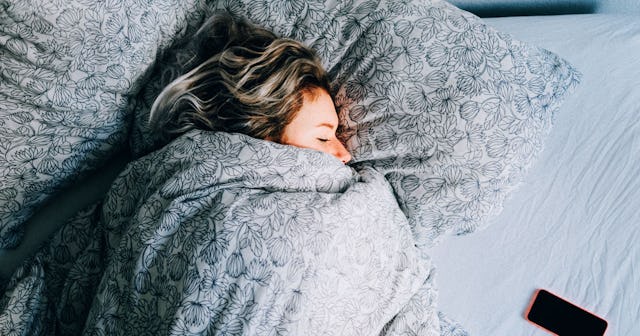What Your Sleep Position Says About Your Health — And Which One Is Best

Sleep, we can all agree, is vitally important for a healthy lifestyle. Getting that requisite 7-9 hours is like a magic elixir; poor sleepers, on the other hand, have an increased risk of heart disease, kidney disease, high blood pressure, diabetes, stroke, and inflammatory bowel disease, not to mention that it can exacerbate anxiety and depression. So quality sleep is more than a luxury; it’s essential. And sleep positions — each with its individual pluses and minuses — matter.
The Much-Maligned Stomach
10 percent of us prefer the stomach, the most demonized of all sleep positions. In some ways, this makes a lot of sense;:flopping in bed face down with your neck cranked to the side has got to do a number on all those vulnerable vertebrae. If you ask the pros, slumbering on your front side is ill-advised, at best. Vivian Eisenstadt, a physical therapist based in Los Angeles, sums up the problem: “[The stomach sleep position] forces your neck to be in a rotated, closed pack, tight position, which also compromises your breathing and circulation.”
That said, the belly-flop sleep position does have the benefit of reducing snoring, which is much more than that cacophonous, elongated snort that makes your partner elbow you in the middle of the night. It is an often undesirable cohort of sleep apnea, which has been linked to high blood pressure, heart disease, and type 2 diabetes.
The Under-Represented Back
Though undeniably the worst choice in terms of apnea, the back is typically touted as the gold standard sleep position, as it can help in preventing wrinkles, taming acne, and easing tension headaches.
Even so, the back sleep position is amazingly unpopular, with 92% of the population avoiding it — and frankly, I have no idea how anyone finds any contentment in this full-frontal rigidity. However, your chiropractor, physical therapist, and orthopedist would agree with Healthline’s Ashley Marcin: “When you sleep on your back, your weight is evenly distributed and spread across the widest area of your body. As a result, you place less strain on your pressure points. You’re also able to get better alignment of your spine and your internal organs.” If you choose to get your zzzz’s with your nose pointed at the ceiling, your saved-from-being-crookedy body will thank you.
If you want to get the most out of the back sleep position, place a bolster under your knees and a small and a rolled towel under the small of your back, plus support your neck with a pillow. So, if your musculoskeletal well-being is at stake and pain is keeping you awake at night, you might want to join that meager 8% of back sleepers. Round up your sleep supplies and have at it.
The Popular-For-A-Reason Side
The mighty side is the most popular sleep position, with 74% of us choosing it. Some argue that the side sleep position is best since it does not force the body to “work twice as hard to breathe” and, at the same time, it doesn’t crunk your back.
In its own right, the side sleep position is also a whiz-bang when it comes to aiding digestion, preventing esophageal juices from flowing upward — which goes a long way towards reducing acid reflux, GERD, and heartburn.
More impressive, though, is that the side is the only one of the three sleep positions that aids in the draining of the glymphatic system. Researchers at Stony Brook University discovered that sleeping on our sides may “more effectively remove brain waste and prove to be an important practice to help reduce the chances of developing Alzheimer’s, Parkinson’s and other neurological diseases.” And if brain health is a priority, the side sleep position may be the route to go.
So what’s best for you?
Of course, the internet offers a plethora of tips to change the default sleep arrangement of your limbs, torso, and everything else.
If apnea keeps you restless and popping awake, you might want to go for that belly. If it’s lower back pain that is your primary nemesis, you’re going to have to go for the straight-as-a-board flat back. If you want to hedge your bets and protect your brain as well, the side sleep position is your oyster.
But the answer to preserving optimal health does not always lie in a specific sleep position, per se. It is also about which position allows you to make the most of your sleep life. We need to remember that sleep itself “has renewing and replenishing effects both physically and emotionally” and that the “quality of sleep is directly related to human health, as well as to the standard of living.”
In the end, quality sleep is key, and whatever nighttime body configuration gets us there is the way to go. So next time I hit the hay, I’m going to curl up in that semi-stomach-fetal contortion with one leg jutting out and my hands crumpled under my twisted neck. And then I’m going to peacefully snooze the night away.
This article was originally published on